HOME
英語の筆記体についてのメモ
2015-10-16(Fri)
どうも英語の筆記体が美しく書くことができないので、改善方法を探ることにした。
一口に筆記体といってもさまざまにあるから、まずどういうスタイルを選択するべきかを決めなくてはならない。また、書道と同じで、あるスタイルを知るためには、その先祖の形を知る必要がありそうだ。
Wikipedia でもちょいちょいと読めば歴史がわかると思っていたが、そうでもなかった。ざっとした話なら、https://en.wikipedia.org/wiki/Cursive#English_cursive を見ればよいが、それだけでは到底足りない。そこで関連する項目を見ていくと、これが驚くほどたくさんあり、Wikipedia を読むだけでも一苦労なのである。そこで、とりあえず私の目的に必要なぶんだけ、手書き文字のカテゴリーを中心としてメモをとることにした。(私の勘違いや理解不足から混乱していると思うので、信用しちゃ駄目ですぞ)
とりあえず、先が平ったいペンで書いたらしいものと、先が尖ったペンで書いたらしいものに分けてメモをとった。
ブロック体的な流れ
[平たいペン先のペンで書く場合、基本的にはつづけ字になることがないので、続け字という意味での「筆記体」ではない(漢字でいえば楷書?)。中世以来、宗教的な写本を作るために広く用いられた。そして、この書きぶりは印刷術の普及とともに姿を消していく。なお、ブラック・レター関連はメモしてない]
Uncial
この系統の書きぶりのキーワードは Uncial(アンシャル体)ということになるだろう。が、とうてい手に負えないので、省略w
https://en.wikipedia.org/wiki/Uncial_script から進化図を借用してお茶を濁すことにする。

"Evolution of minuscule based on several sources but mainly for convenience from a calligraphy book [1] but corrected the various incorrect forms (j v and w removed, z and s changed)[2].([1] David Harris, The Calligrapher's Bible: 100 Complete Alphabets and How to Draw Them, 2003, [2] http://medievalwriting.50megs.com/scripts/letters/letters.htm#letterindex)"
作者:Squidonius
https://commons.wikimedia.org/wiki/File:Evolution_of_minuscule.svg より。
Caroling minuscule
Caroling minuscule は Roman half uncial から進化したものである。800年 から 1200年頃神聖ローマ帝国で使われた書きぶりで、ヨーロッパに広く通用した。これはその後ブラック・レターに進化し、caroling minuscule 自体は書かれなくなっていく。シャルルマーニュが文字を勉強したというのもこの書体であろう。(参考 https://en.wikipedia.org/wiki/Carolingian_minuscule )
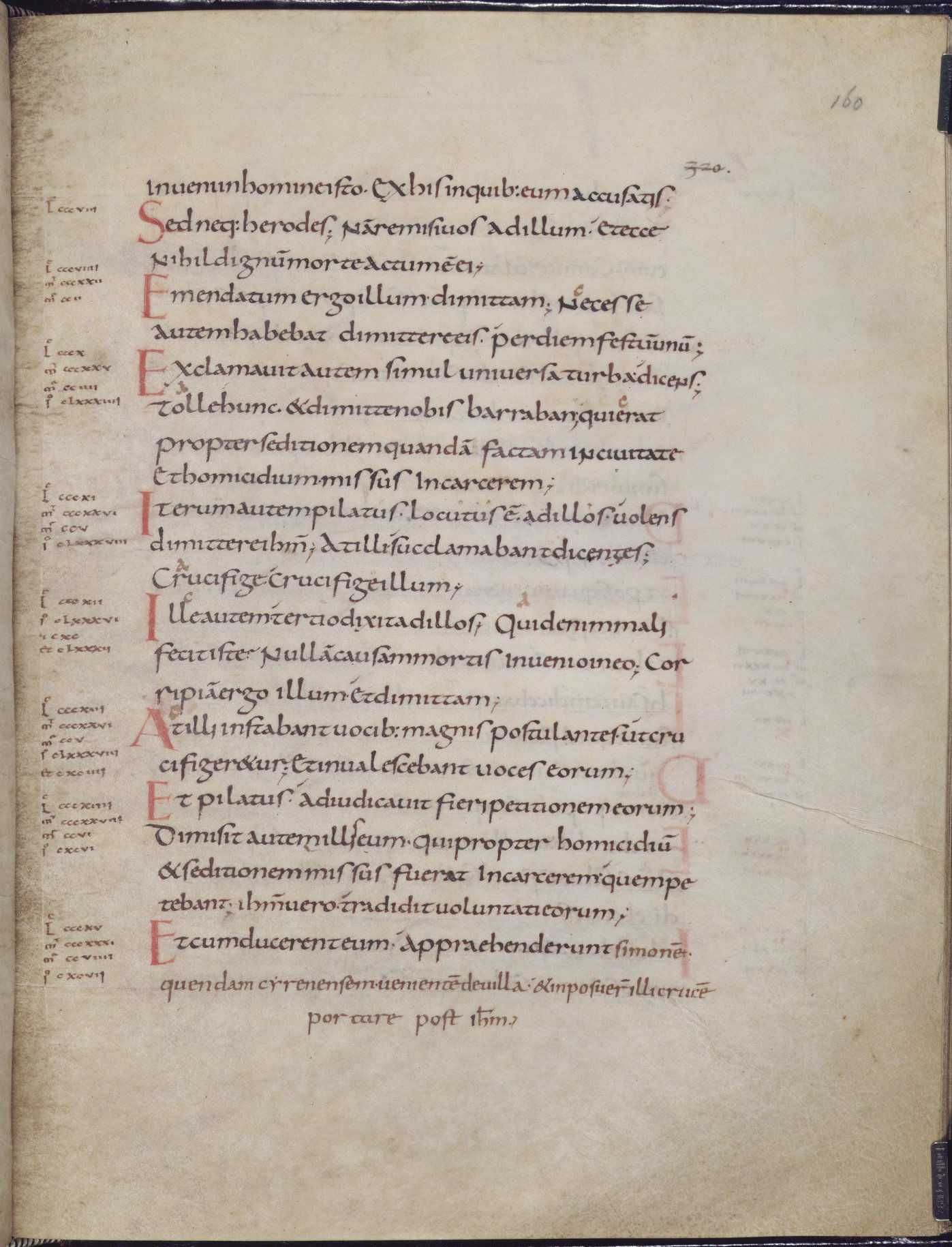
カロリング朝の福音書の一ページ。https://en.wikipedia.org/wiki/File:Minuscule_caroline.jpg より。元ソース、http://www.bl.uk/catalogues/illuminatedmanuscripts/record.asp。
Humanist minuscule
ルネサンスの頃になると、古代ローマに憧れた文人たちが 800年 から 1200年頃に神聖ローマ帝国で使われた Carolingian minuscule 真似て、Humanist minuscule (参考 https://en.wikipedia.org/wiki/Humanist_minuscule )と呼ばれるものを書いた。彼らにとって、それはブラック・レターに対してローマ的なものだった。
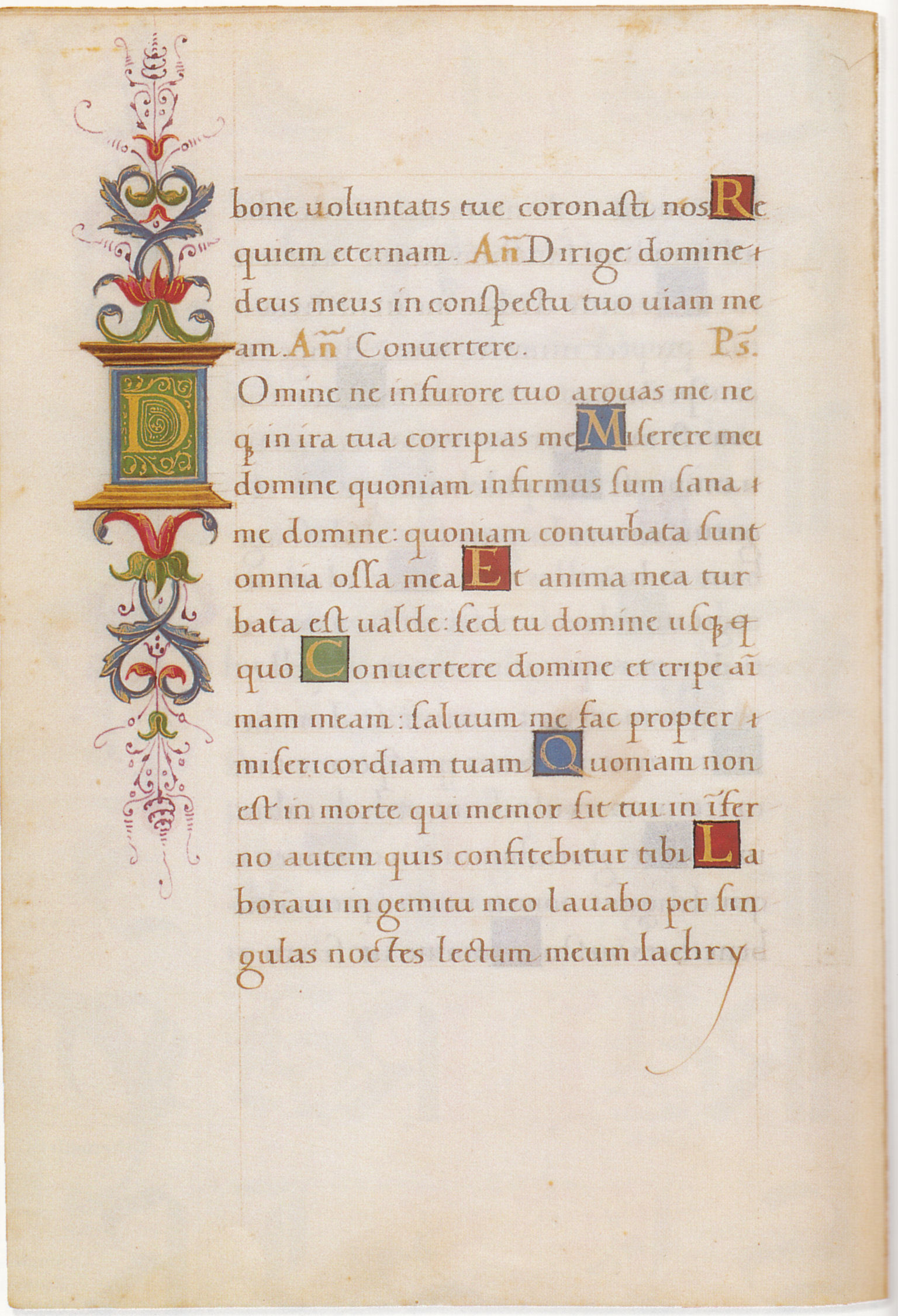
humanist miniscule の例。Page from the Book of Hours of Giovanni II Bentivoglio, Bologna, c. 1497-1500, humanist minuscule with decorations. 元ソース:David Harris, The Art of Calligraphy, Dorling Kindersley 1995, ISBN 1564588491。https://commons.wikimedia.org/wiki/File:Book_of_Hours_Bentivoglio.jpg より。
Italic script
Humanist minuscule は書くのに時間がかかったので、Niccolò de' Niccoli (1364–1437)が、現在 Italic script と呼ばれるものを発明した(参考 https://en.wikipedia.org/wiki/Italic_script )。Italic script は、Humanist minuscule よりも画数が少なく、斜めに傾いており、文字と文字が続けて書かれたりした。これは、いずれも素早く書くための工夫であった。(参考 https://en.wikipedia.org/wiki/Niccol%C3%B2_de'_Niccoli および https://en.wikipedia.org/wiki/Niccol%C3%B2_de'_Niccoli#/media/File:Niccolo_de_Niccoli_italic_handwriting.jpg )。1440年にグーテンベルグが印刷術を普及されると、Italian script は衰退する。
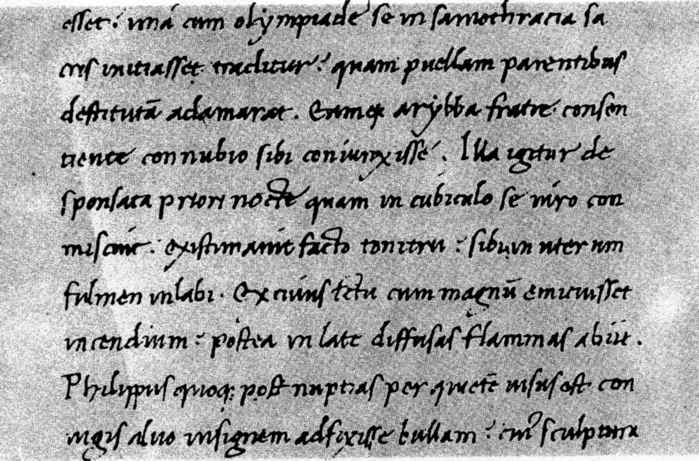
" Handwriting by Niccolò de' Niccoli (1364–1437), which served as the origin of italic type."
著者:Niccolò de' Niccoli
元ソース:Written by Niccolò de' Niccoli (1364–1437). Copied in The Origin and Development of Humanistic Script by Berthold Louis Ullman (Rome, 1960), Plate 37 Florence, Naz. Conv. Soppr. I. X. 44, folio 1v Lives of Alexander and Caesar translated by Guarino. Scanned by HDoug of The Fountain Pen Network. Posted on "italic" term in computers and writing. Uploaded to en.wikipedia by Wareh. Transferred to Commons by User:朝彦 using CommonsHelper.
https://commons.wikimedia.org/wiki/File:Niccolo_de_Niccoli_italic_handwriting.jpg より。
Cursive chancery hand (参考 https://en.wikipedia.org/wiki/Chancery_hand#Cursive_chancery_hand) というのは、この Itarian script の系統である。
筆記体的な流れ
[尖ったペン先で書く場合、自然と装飾的に流れる線が表われるものらしい。また、連綿に書くことも行われるようになり、h や b や f を連綿に書くためのループが現れてくる。印刷術の普及以後も書かれ続けたのは、おおむね写本以外の文書で使われてきたせいだろう。タイプライターが普及して以後は、以前に比べて書かれることが少なくなり、手書きをする場合でもブロック体で済ませることが多くなってきている。とはいえ、学校教育の中で教えられ続けている]
Chancery hand
ここで少し時代を戻すと、13世紀に Chancery hand という書き方がローマの Lateran chancery (the Cancelleria Apostolica) で生まれる。これは、1350年にはイギリスでも使われるようになる(これらは Cursive chancery hand とは別物)。(参考 https://en.wikipedia.org/wiki/Chancery_hand#Cursive_chancery_hand)
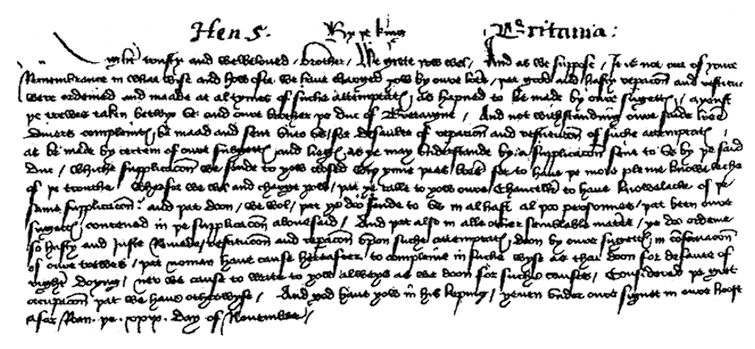 English chancery hand の例。ヘンリ 5 世の手紙。Facsimile letter of Henry V of England, 1418。https://en.wikipedia.org/wiki/File:English_chancery_hand_1418.png より。
English chancery hand の例。ヘンリ 5 世の手紙。Facsimile letter of Henry V of England, 1418。https://en.wikipedia.org/wiki/File:English_chancery_hand_1418.png より。
Secretary hand
16世紀くらいになると、イギリスで Secretary hand と呼ばれる形が使われるようになり、これは個人的な文書にも、公文書にも使われたという。これは、現在われわれが筆記体と言ったときに想像するものに近い。(参考 https://en.wikipedia.org/wiki/Secretary_hand )
シェイクスピアの原稿や遺言書は、この secretary hand で書かれている。(参考 https://en.wikipedia.org/wiki/Shakespeare's_handwriting )

シェイクスピアの遺言書。https://en.wikipedia.org/wiki/File:Shakespeare-Testament.jpg より。
ちょっと見ても解読できないが、シェイクスピアの同時代人が出版した手本( https://commons.wikimedia.org/wiki/File:Secretary_hand.jpg )なんかが手掛りになりそう。余談ながら、s はわれわれが馴染んでいる s の他にロング s と呼ばれるもの(ユニコードでは「ſ」)も書かれている。h や b や f にループ状の部分があることも観察できる。
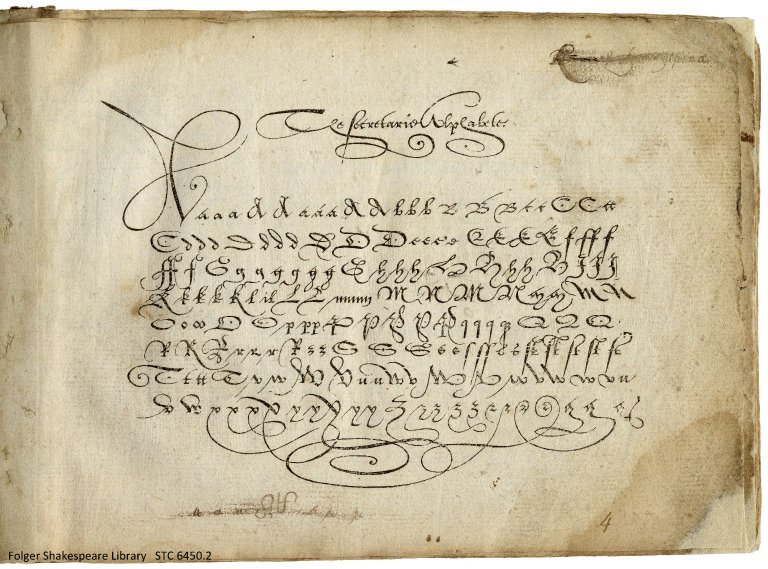
Secretary hand の見本。(An alphabet page for the secretary hand, from a penmanship book published in England in 1570)。元ソース:The Folger Shakespeare Library。作者:Jehan de Beau-Chesne and John Baildon。https://commons.wikimedia.org/wiki/File:Secretary_hand.jpg より。
Round Hand
ルネサンス時代に Apostolic Camera(http://www.cbcj.catholic.jp/jpn/vatican/curia.htm によると教皇空位期間管理局と訳すらしい。Lateran chancery、the Cancelleria Apostolica とも)が italic cursiva を作り出した(前述の Chancery hand というのはこれと同じか近いもの?)1527年のローマ略奪を逃れてイタリアからフランスに行った職人がこれを talic circumflessa に改良した。これが 17 世紀初頭にフランス流に変化して rhonde となった。英国では 1680 年代に John Ayres と William Banson がさまざまな rhonde を改良・普及・流行させたが、それが English round hand である。(参考 https://en.wikipedia.org/wiki/Round_hand)
English round hand は copperplate script(カタカナにするときはコッパープレートではなくカッパープレートと表記されることが多いようだ)と呼ばれることがあるが、これは学習者が銅版のエッチングによる手本を使って学んだことに由来する。
アメリカ独立宣言(1776年)は、この書体を用いている(参考 https://en.wikipedia.org/wiki/Copperplate_script)。
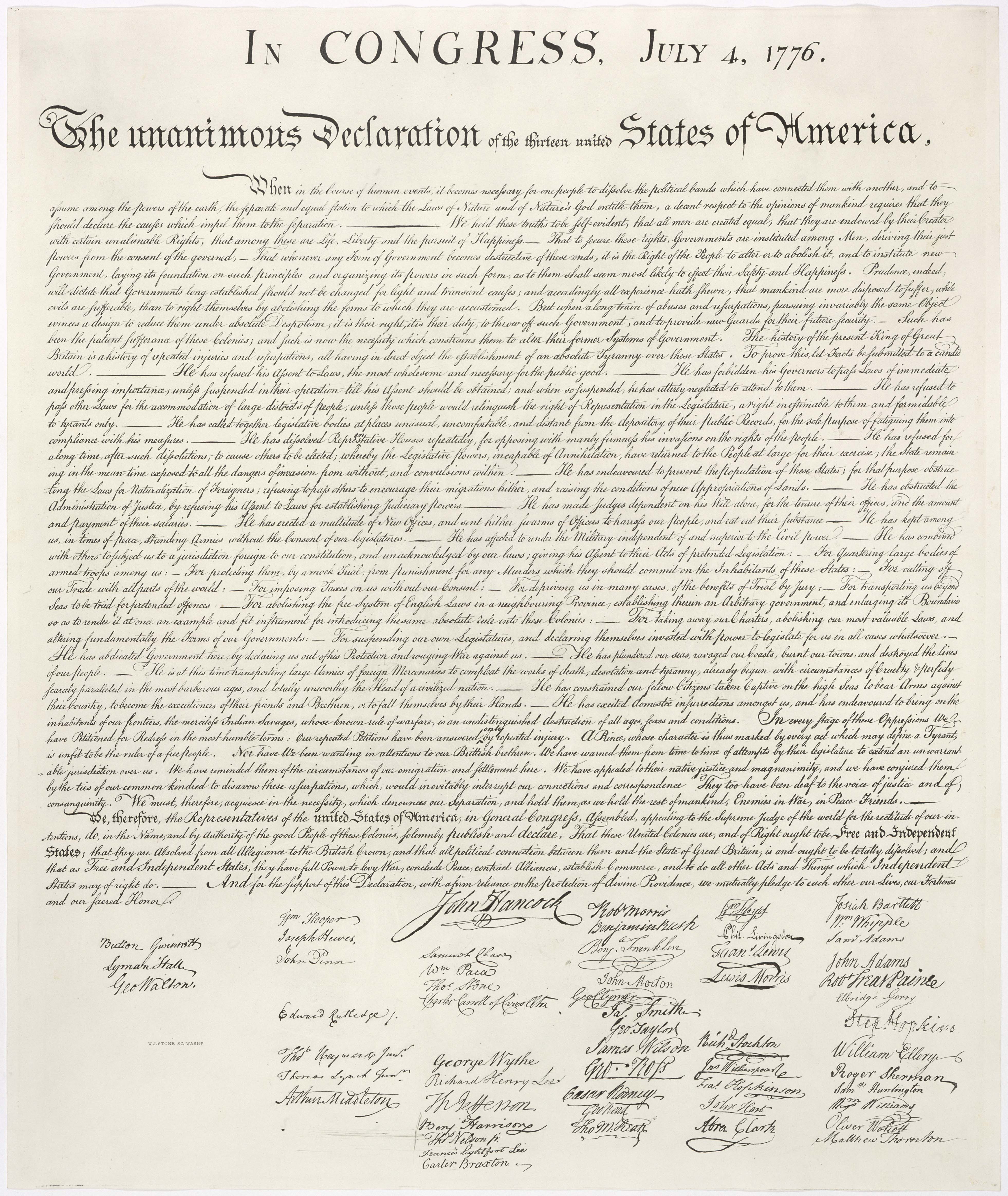
アメリカ独立宣言。https://commons.wikimedia.org/wiki/File:United_States_Declaration_of_Independence.jpg より。
round hand の実例は後でちょっと詳しく見ていくことにする。→ roundhand の観察
Spencerian script
アメリカでは、1850年から1925年にかけて Spencerian script と呼ばれるスタイルがいわゆるデファクトスタンダードとしてビジネス文書で広く用いられた。(現在でもコカ・コーラやフォードのロゴに Spencerian script を見ることができる。)ビジネス文書で Spencerian script が用いられなくなったのは、タイプライターが普及したからである。なお、書体の名は発明者の Platt Rogers Spencer から取ったもの。(参考 https://en.wikipedia.org/wiki/Spencerian_script)
ちなみに、タイプライターは 1860 年代に発明され、その後改良・普及していったものである。(参考 https://en.wikipedia.org/wiki/Typewriter)
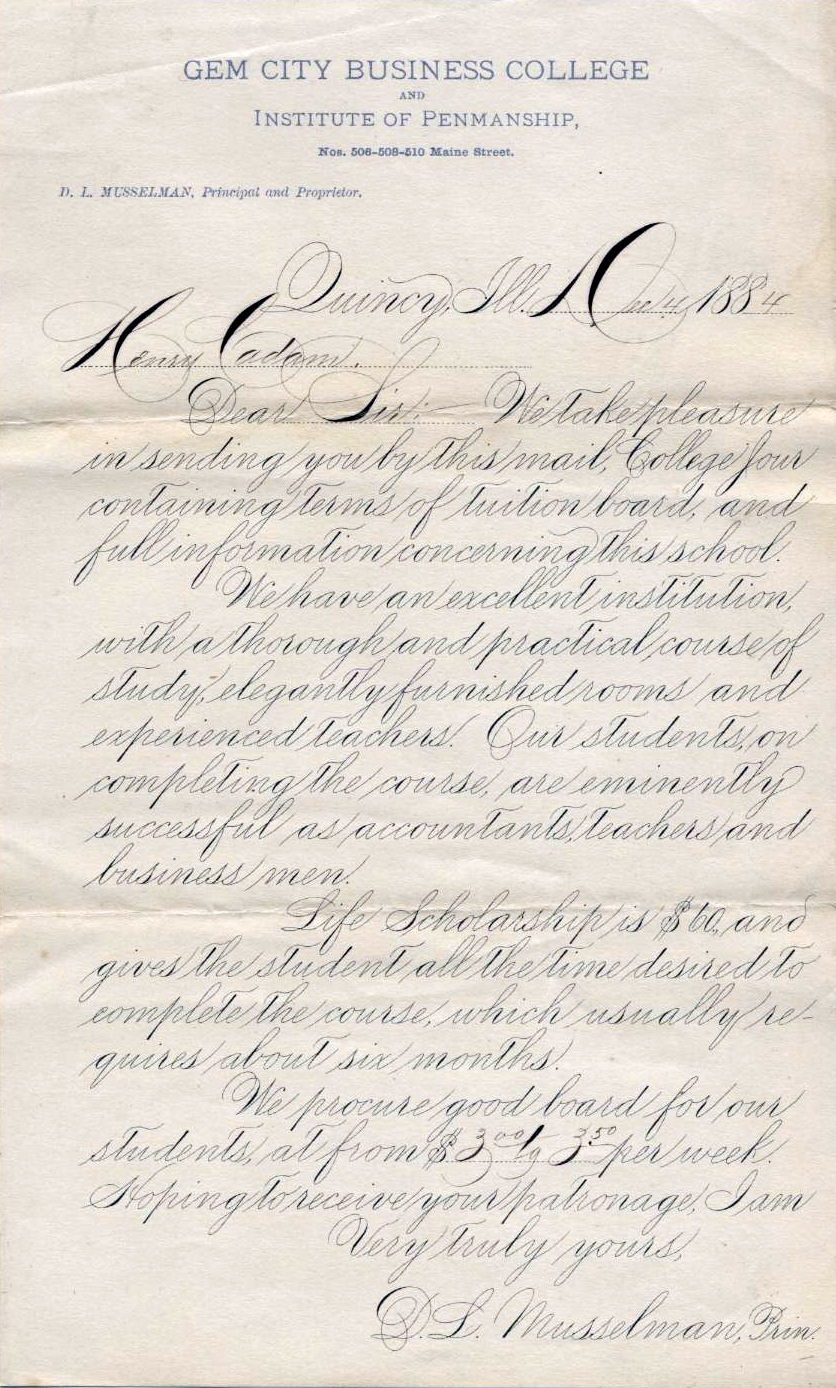
Spencerian script の例。https://en.wikipedia.org/wiki/File:Spencerian_example.jpg より。元ソース、http://www.iampeth.com/lessons.php#spencerian。作者:D.L. Musselman
なお、「スペンセリアン・ペンマンシップによる筆記体書法-その史的展開と基礎理論-」(http://hdl.handle.net/10087/9384 )に、Spencerian の理論が紹介されている。
Palmer Method
Spencerian script はビジネス・シーンでタイプライターに取って代わられたが、学校教育の現場では Palmer Method と呼ばれる書き方に取って代わられる。Palmer Method は 19 世紀後半から 20 世紀にかけて Austin Palmer が発案して広めた書き方である。1894年に出版された Palmer's Guide to Business Writing という本はアメリカでミリオンセラーになった。Palmer Method は、1840年代から普及している Spencerian Method を簡略化して素早く書けるようにしたものだ。(参考 https://en.wikipedia.org/wiki/Palmer_Method)
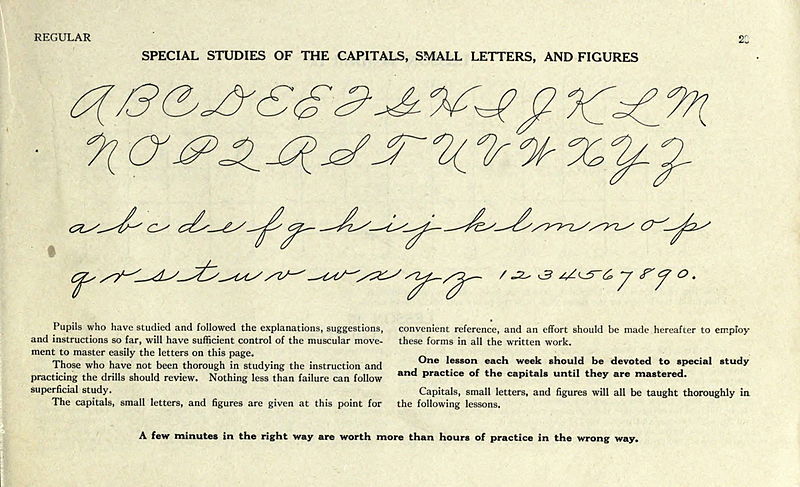
Palmer Method によるアルファベット。https://en.wikipedia.org/wiki/File:Palmer_Method_alphabet.jpg より。作者:A. N. Plamer
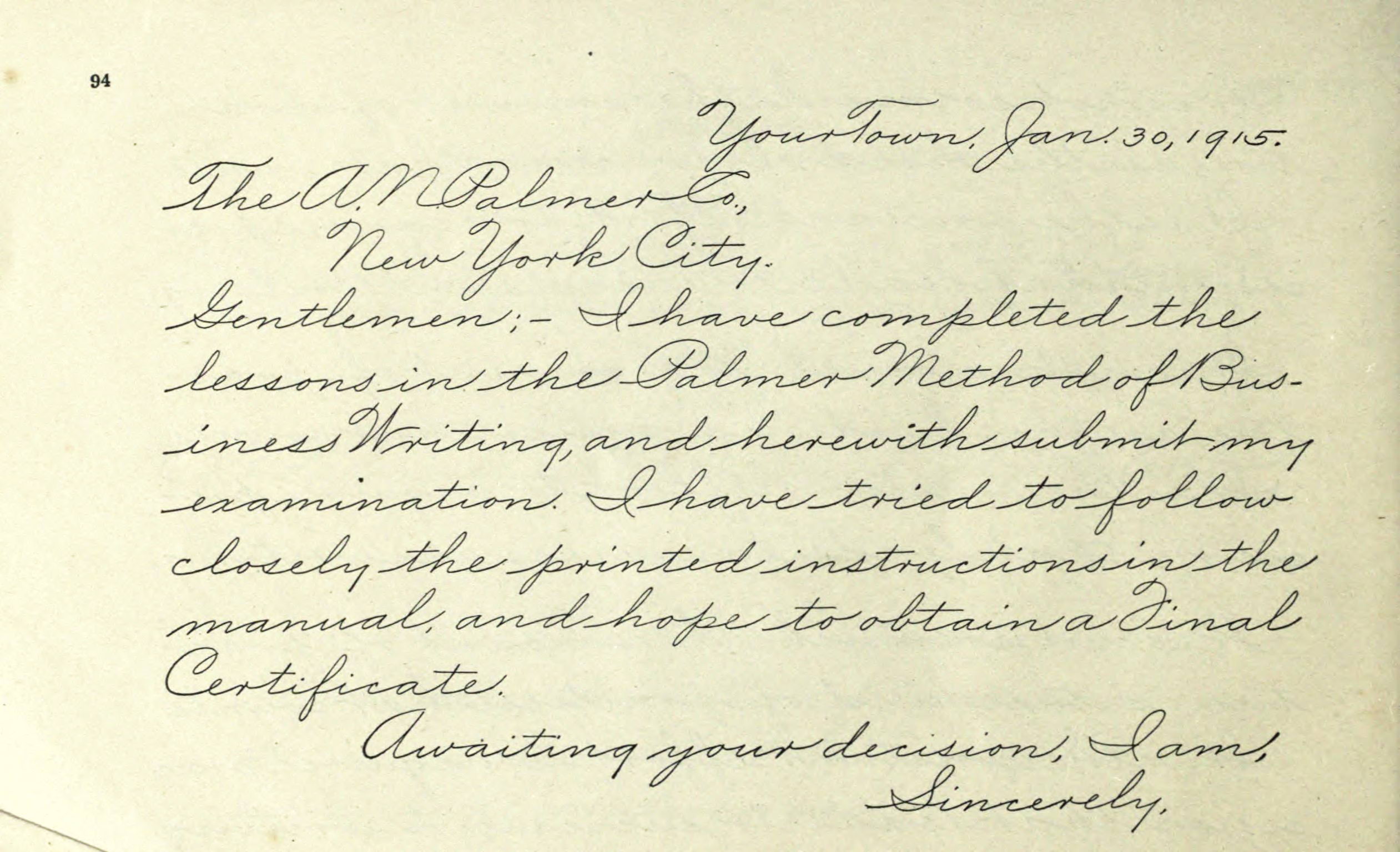
Palmer Method によるビジネス文書の例。https://en.wikipedia.org/wiki/File:Palmer_Method_sample.jpg より。作者:A. N. Plamer
現代の筆記体
[以後のスタイルに関して Wikipedia を見ると、項目に対して "needs additional citations for verification" というコメントが目立つようになる。]
[日本語 wikipedia の「筆記体」の項( https://ja.wikipedia.org/wiki/筆記体 )は「20世紀後半には『D'Nealian式』や『Zaner-Bloser式』などの多様な新しい筆記体が現れた。それぞれが標準化されないまま、さまざまな手書き文字が、異なる英語圏国家の異なる学校制度の下で用いられるようになった。」と書いている。]
Wikipedia の Palmer Method の項(https://en.wikipedia.org/wiki/Palmer_Method)によると、Palmer Method は 1950 年代になると人気が落ちていき、Zaner-Bloser method に取って代わられたと書ある。Wikipedia の Zaner-Bloser, Inc. に関する項(https://en.wikipedia.org/wiki/Zaner-Bloser で 2015年10月17日現在 "needs additional citations for verification" のコメントあり)には、1904年に Zaner & Bloser Company は The Zaner Method of Arm Movement Writing が出版され、単純化した Zenerian writing style を全米の小学生が学べるようになったとあるが、この部分については "citation needed" のコメントがついている。なお、The Zaner Method of Arm Movement Writing は https://archive.org/details/armmovementmetho00zane で見ることができる。
現在、Zaner-Bloser, Inc は印刷された教材のほか、スマートフォン向けの筆記体学習アプリを発売している。https://itunes.apple.com/us/app/zaner-bloser-handwriting-cursive/id426939778
Wikipedia の D'Nealian の項目(https://en.wikipedia.org/wiki/D'Nealian で2015年10月17日現在 "needs additional citations for verification" のコメントあり)には、D'Nealian は Palmer Method から派生したスタイルでで、楽に手書きできることを目指した、教育を念頭に置く筆記体とブロック体であるとか書かれている。なおブロック体について、猿の尻尾がついているという批判がある(https://en.wikipedia.org/wiki/File:D'Nealian_Manusript.png を見ると「猿の尻尾」と言われるものが何なのかがわかる)。
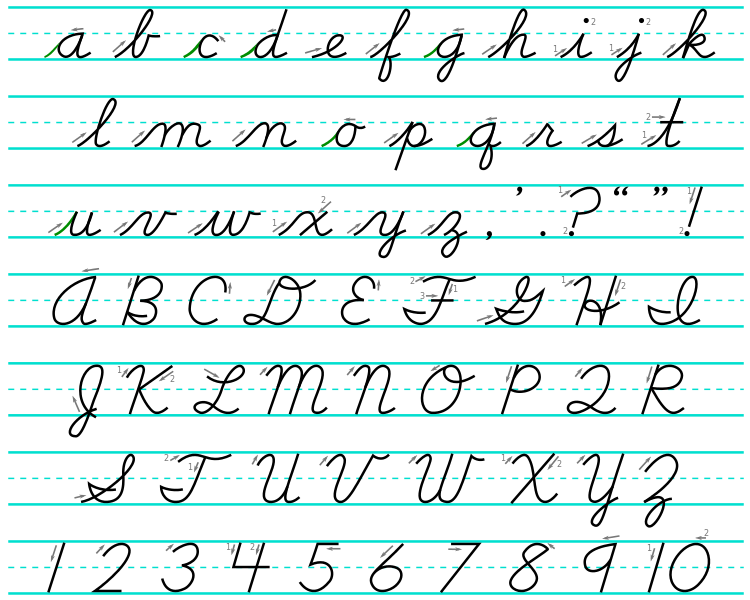
D'Nealian の筆記体。https://commons.wikimedia.org/wiki/File:Cursive.svg より。作者:AndrewBuck。
イタリック・スクリプト復興運動
20世紀になって、主流であるループのある筆記体に対して Italic script を推進する運動が起こる。https://en.wikipedia.org/wiki/Italic_script によると、"The style Italic script used today is often heavily influenced by developments made as late as the early 20th century. " ということである。英国においては、 Alfred Fairbank's book A Handwriting Manual (1932) がこうしたリバイバルの一翼を担い、1976年には、イタリック・スクリプトの現代版が Getty-Dubay と呼ばれている( https://en.wikipedia.org/wiki/Italic_script 参照)
実際のところ、それは「1960年代以降、筆記体の教育の重要性に疑問が持たれ始める。単純にローマ字を傾斜させたイタリック体はより平易なものであり、伝統的な筆記体を不要にするものであるとの議論が巻き起こった。」(https://ja.wikipedia.org/wiki/筆記体)ということらしいのだが。
この Getty-Dubay がどのようなものかは、Inga Dubay と Barbara Getty が The New York Times に寄稿した http://www.nytimes.com/interactive/2009/09/04/opinion/20090908_opart.html を見ると概略を知ることができる。
日本の学校で学ぶ筆記体
2015年現在、中学校の学習指導要領では、英語の筆記体は教えてもよいが教えなくてもよい、という位置づけになっているらしい(参考 http://www.mext.go.jp/a_menu/shotou/new-cs/youryou/chu/gai.htm)。
この筆記体にはさまざな形があるが、これを教える場合にはたいがい "looped" と表現される種類の形のようである。この「標準的」な形がどういうものかは、たとえば http://hon.gakken.jp/reference/column/Q-A/article/100721.html を見るとわかる。これは、かなり D'Nealian に近い。
なお、日本の筆記体教育の歴史については、https://ja.wikipedia.org/wiki/%E7%AD%86%E8%A8%98%E4%BD%93#.E6.95.99.E8.82.B2 に紹介がある。
round hand の観察
とまあそういうわけで、手書き文字の歴史を覗いてみたのだが、面白そうなのは round hand あたりだと考えた。そのまま実用シーンに書くかどうかは別問題として、学ぶことは多そうである。
サンプル
次に english round hand の例として掲げるのは George Bickham the Elder (1684–1758) の手紙である。
Bickham は、1740年に The Universal Penman という本をエッチングで出版し、これは 18 世紀の English round hand の普及に貢献することとなる。(参考 https://en.wikipedia.org/wiki/George_Bickham_the_Elder ) 。(この本は現在でも複製して販売されている http://www.amazon.co.jp/gp/product/0486206165 。Bickham の本では、この他に "George Bickham's Penmanship Made Easy (Young Clerks Assistant)" が手に入る http://www.amazon.co.jp/dp/0486297799 。また、https://books.google.co.jp/books/ でスキャンした1743年版の画像を部分的にプレビューすることができる https://books.google.co.jp/books?id=GhlB2XL3RbkC&lpg=PP1&hl=ja&pg=PA65#v=onepage&q&f=false )。手紙の相手は、カリグラファーの Nathaniel Dove で The Universal Penman のために作品を寄せている。(参考 https://en.wikisource.org/wiki/Dove,_Nathaniel_%28DNB00%29)
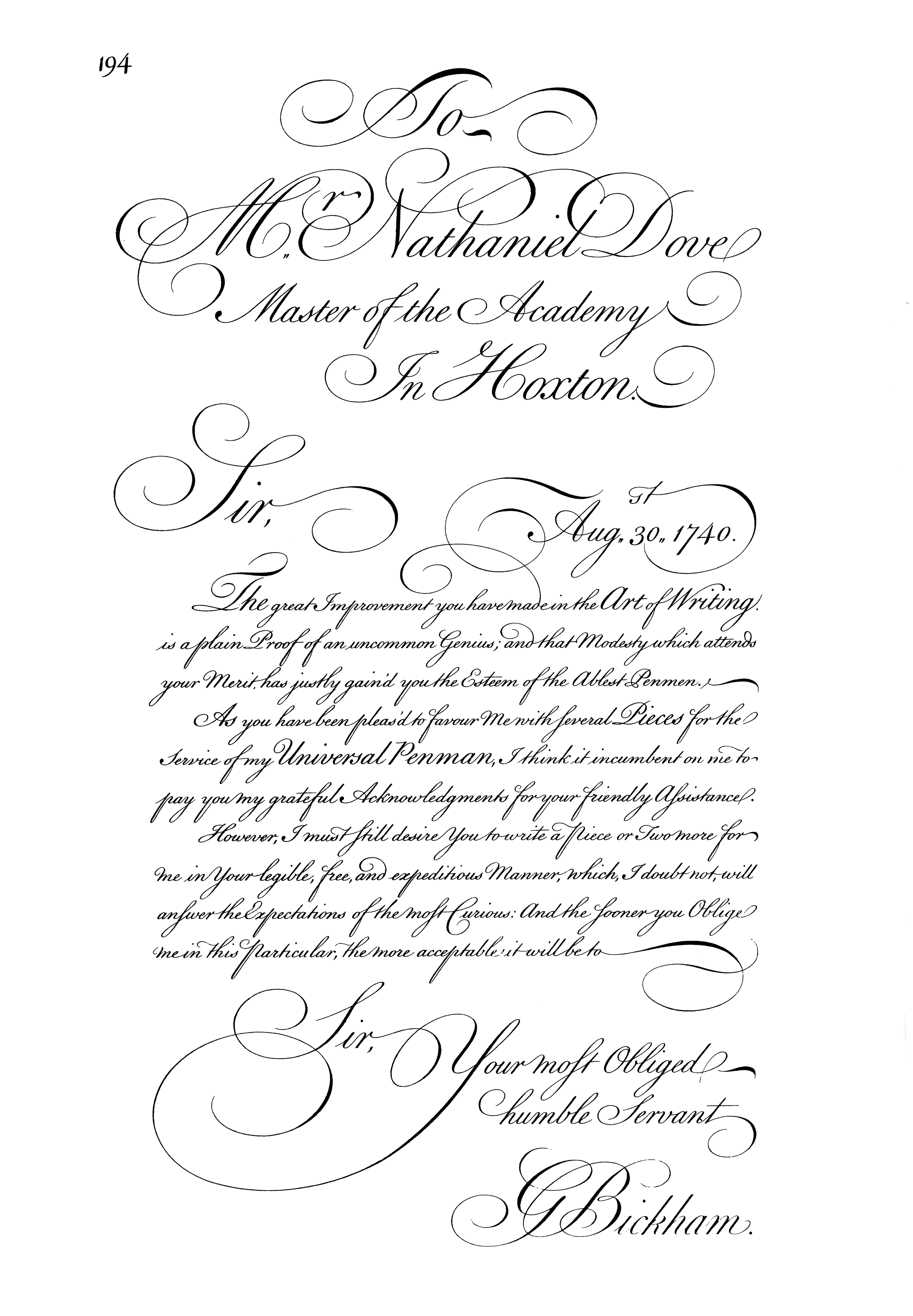
[Page 194 of The Universal Penman, first published c. 1740–1741. An example of George Bickham's English roundhand lettering and engraving skills/
https://commons.wikimedia.org/wiki/File:Bickham-letter.png より
作者:George Bickham ]
文字起こしをしてみると、次の通り。
To Mr Nathaniel Dove
Master of the Academy In Hoxton.
Augst 30 1740.
Sir, The great Improvement you have made in the Art of Writing is a plain Proof of an uncommon Genius; and that Modesty which attends your Merit has justly gaind you the Esteem of the ablest Penmen. As you have been pleas'd to favour me with ſeveral Pieces for the service of my Universal Penman, I think it incumbent on me to pay you my grateful Acknowledgements for your friendly Aſsistance. However, I must ſtill desire you to write a Piece or Two more for me in Your legible, free, and expeditious Manner, which I doubt not, will anſwer the Expectations of the moſt Curious: And the ſooner you Oblige me in this particular, the more acceptable it will be to, Sir,
Your moſt Obliged humble Servant G Bickham.
ホクストンのアカデミー長ナサニエル・ドウブ様
1740年8月30日
拝啓。あなたがライティング技術にもたらした改良はまさに類い稀なる才能の証明であります。そして、あなたの長所にともなうつつましさは、すべての能書家の尊敬を得ているところであります。あなたが、拙著 Universal Penman のために何点かの作品を快く書いて下さったのですから、私はあなたに親切な援助に対して感謝を込めたお礼状を書かなくてはならないと思いました。しかしながら、私のためにもう一、二点、あなたの読みやすくのびのびとして、てきぱきとした書きぶりで——私はそれが最高の目ききたちの期待に応えるだろうと信じます——書いていただけたらと思います。できるけ早くお願いできればと存じます。
敬具
G・ビックハム
2 種類の s
ここに登場する s に二種類の表記がある。一つは我々に馴染みのある で、もう一つは
で、もう一つは
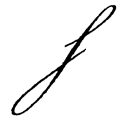
という形をした、ロングエスと呼ばれるものだ(参考 https://ja.wikipedia.org/wiki/%E9%95%B7%E3%81%84s )。当時は活字でもこれらに別の活字を用いていた。
活字体のロングエスは f に似た ſ が用いられることが多い。現在でもユニコードでは s とは別のコードポイントが割り当てられている('LATIN SMALL LETTER LONG S' (U+017F))。ちなみに、ユニコードの ʃ は"LATIN SMALL LETTER ESH" (U+0283)で発音記号に用いられ、∫は "INTEGRAL" (U+222B)で、積分記号である。
上述のサンプルで s と ſ がどう使い分けられているかを見てみる。s を緑色の文字で ſ を赤色の文字で示した。
To Mr Nathaniel Dove
Master of the Academy In Hoxton.
Augst 30 1740.
Sir, The great Improvement you have made in the Art of Writing is a plain Proof of an uncommon Genius; and that Modesty which attends your Merit has justly gaind you the Esteem of the ablest Penmen. As you have been pleas'd to favour me with ſeveral Pieces for the service of my Universal Penman, I think it incumbent on me to pay you my grateful Acknowledgements for your friendly Aſsistance. However, I must ſtill desire you to write a Piece or Two more for me in Your legible, free, and expeditious Manner, which I doubt not, will anſwer the Expectations of the moſt Curious: And the ſooner you Oblige me in this particular, the more acceptable it will be to, Sir,
Your moſt Obliged huble Servant G Bickham.
Wikipedia 「長い s」の項によると、「(ſ は)語頭・語中において用いられた。原則として、語末・ アポストロフィーの前・fの前後・b, kの前においてのみ短いsを用いた。」とある。
私たちのサンプルでは、語末では s しか用いられていないものの、かなり自由に s と ſ が使い分けられていて、上の原則では ſ を用いてよい場所でも s が用いられている。
 の後に文字が続く場合
の後に文字が続く場合
さて、 の終筆部分には、まるで音符のような黒丸が観察できる。この文字を書いた後は一旦ペンを用紙から離したと思われる。たとえば、
の終筆部分には、まるで音符のような黒丸が観察できる。この文字を書いた後は一旦ペンを用紙から離したと思われる。たとえば、

この部分は、s を書き終えてから、あらためて t に続くようにつなげたように見える。
このサンプルと同じ english round hand という書きぶりによるアメリカ独立宣言でも、事情は同じである。ただし、終筆地点にある黒丸は存在しない。(次の例はアメリカ独立宣言の一部で https://commons.wikimedia.org/wiki/File:United_States_Declaration_of_Independence.jpg より)

Spencerian 以後のスタイルでは、s の終筆後にペンの軌跡をなぞるように逆行してでも s と t を続けて書くのが一般的で、中学校の英語でも筆記体を習うときは、そのように教えられていると思う。(次の例は Spencerian で https://en.wikipedia.org/wiki/File:Spencerian_example.jpg の一部分)

 の下に凸になっている部分の曲がり方
の下に凸になっている部分の曲がり方
 がどうして s なのかというと、たぶん
がどうして s なのかというと、たぶん
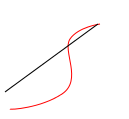 の赤い部分が本体で、それに黒い部分がついたのだと思う(何の根拠もなく言うけどw)。もしそうなら、赤い部分はくねっと曲がっているのが由緒正しいことになりはしないか。
の赤い部分が本体で、それに黒い部分がついたのだと思う(何の根拠もなく言うけどw)。もしそうなら、赤い部分はくねっと曲がっているのが由緒正しいことになりはしないか。
この部分は、round hand や Spencerian までは微妙に「くにゃっ」とした s 字の痕跡を残している(数学的に言うと変曲点を持つ)が、Palmer になると単調な弧になってしまい、D'Nealian はそれを受け継いでいる。
2 種類の t
小文字の t は、2 種類のものが書かれている。一つは、 (筆順がわかるように書くと
(筆順がわかるように書くと )のように縦画と横画を一気に書く書き方で、次の字に続くのは横画のほうである。もう一つは
)のように縦画と横画を一気に書く書き方で、次の字に続くのは横画のほうである。もう一つは や
や のようなもので、縦画だけ書いておき、単語を書き終えてから横画を足すものである。こちらは、縦画のほうが次の字に続く。
のようなもので、縦画だけ書いておき、単語を書き終えてから横画を足すものである。こちらは、縦画のほうが次の字に続く。
サンプルから、それぞれを探し、 タイプは赤字で、
タイプは赤字で、 タイプは緑字で示してみた。なお、アンダーラインの箇所は大きな字で強調されている部分である。
タイプは緑字で示してみた。なお、アンダーラインの箇所は大きな字で強調されている部分である。
To Mr Nathaniel Dove
Master of the Academy In Hoxton.
Augst 30 1740.
Sir, The great Improvement you have made in the Art of Writing is a plain Proof of an uncommon Genius; and that Modesty which attends your Merit has justly gaind you the Esteem of the Ablest Penmen. As you have been pleas'd to favour me with ſeveral Pieces for the service of my Universal Penman, I think it incumbent on me to pay you my grateful Acknowledgements for your friendly Aſsistance. However, I must ſtill desire you to write a Piece or Two more for me in Your legible, free, and expeditious Manner, which I doubt not, will anſwer the Expectations of the moſt Curious: And the ſooner you Oblige me in this particular, the more acceptable it will be to, Sir,
Your moſt Obliged humble Servant G Bickham.
ほとんどが、 タイプになっていることがわかる。
タイプになっていることがわかる。
 タイプで書いている箇所を見ると、(1) 宛て書きなどで強調されている大きな字の部分、(2) e に続く場合、(3) attend のように tt と続く部分である。
タイプで書いている箇所を見ると、(1) 宛て書きなどで強調されている大きな字の部分、(2) e に続く場合、(3) attend のように tt と続く部分である。
 は低い位置からも高い位置からも起筆でき、終筆は高い位置になる。一方、
は低い位置からも高い位置からも起筆でき、終筆は高い位置になる。一方、 は起筆も終筆も低い位置にある。このへんが e に続く場合に
は起筆も終筆も低い位置にある。このへんが e に続く場合に が選択された理由かもしれない。
が選択された理由かもしれない。
なお、この二種類の t の書きぶりがあることは、アメリカ独立宣言でも同じである。that の例を示す。

[https://commons.wikimedia.org/wiki/File:United_States_Declaration_of_Independence.jpg より、アメリカ独立宣言の一部]
単語先頭の t
the のように単語の初めに t が来(てかつ、前の単語と切断されてい)る場合は、 の起筆の前に装飾的な曲線が付加されていることがある。
の起筆の前に装飾的な曲線が付加されていることがある。

これは、大文字のようにも見えるが、次のような形と比べてみると、やはり小文字だという気になる。後者では、起筆に続く丸まった部分は飾りではなくて横画としての意味を持っている。

一箇所、不思議な箇所がある。must ſtill (ſ はロングエス)と続く箇所で、must の s の起筆に飾りがついているのだ。
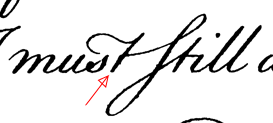
s の後に t が来ている他の箇所では、そのようなことはない。
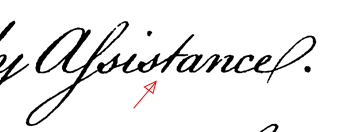
2 種類の r
r は二種類ある。一つは で、もう一つは
で、もう一つは である。
である。
サンプルにおける使い分けを調べてみる。緑字が で、赤字が
で、赤字が だ。(なお、アンダーラインを引いた箇所は強調のため大きく書かれている部分。)
だ。(なお、アンダーラインを引いた箇所は強調のため大きく書かれている部分。)
To Mr Nathaniel Dove
Master of the Academy In Hoxton.
Augst 30 1740.
Sir, The great Improvement you have made in the Art of Writing is a plain Proof of an uncommon Genius; and that Modesty which attends your Merit has justly gaind you the Esteem of the ablest Penmen. As you have been pleas'd to favour me with ſeveral Pieces for the service of my Universal Penman, I think it incumbent on me to pay you my grateful Acknowledgements for your friendly Aſsistance. However, I must ſtill desire you to write a Piece or Two more for me in Your legible, free, and expeditious Manner, which I doubt not, will anſwer the Expectations of the moſt Curious: And the ſooner you Oblige me in this particular, the more acceptable it will be to, Sir,
Your moſt Obliged humble Servant G Bickham.
これを見る限り、使い分けは簡単で (1) 強調のため大きく書かれている文字では を使う (2) 単語の末尾では
を使う (2) 単語の末尾では を使う。その他は
を使う。その他は である。
である。
おわり




 English chancery hand の例。ヘンリ 5 世の手紙。Facsimile letter of Henry V of England, 1418。https://en.wikipedia.org/wiki/File:English_chancery_hand_1418.png より。
English chancery hand の例。ヘンリ 5 世の手紙。Facsimile letter of Henry V of England, 1418。https://en.wikipedia.org/wiki/File:English_chancery_hand_1418.png より。







 で、もう一つは
で、もう一つは



 の赤い部分が本体で、それに黒い部分がついたのだと思う(何の根拠もなく言うけどw)。もしそうなら、赤い部分はくねっと曲がっているのが由緒正しいことになりはしないか。
の赤い部分が本体で、それに黒い部分がついたのだと思う(何の根拠もなく言うけどw)。もしそうなら、赤い部分はくねっと曲がっているのが由緒正しいことになりはしないか。 (筆順がわかるように書くと
(筆順がわかるように書くと )のように縦画と横画を一気に書く書き方で、次の字に続くのは横画のほうである。もう一つは
)のように縦画と横画を一気に書く書き方で、次の字に続くのは横画のほうである。もう一つは や
や のようなもので、縦画だけ書いておき、単語を書き終えてから横画を足すものである。こちらは、縦画のほうが次の字に続く。
のようなもので、縦画だけ書いておき、単語を書き終えてから横画を足すものである。こちらは、縦画のほうが次の字に続く。




 で、もう一つは
で、もう一つは である。
である。